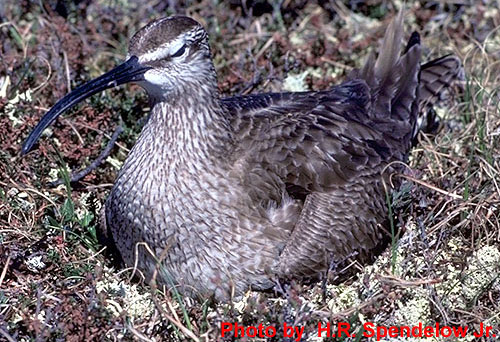| Kingdom: Animalia Phylum: Chordata Class: Aves (Birds) Order: Charadriiformes Family: Scolopacidae |
|
Whimbrel (Numenius phaeopus) is a widespread winter visitor to coastal regions of India. Size: 40-46 cm. Description: The long, down-curved bill varies in length from 7-10 cm, depending upon age and sex. Adults: Upperparts dull brown more or less marked with buff; crown blackish brown with a central buffy gray stripe; buffy gray line above and a dark brown line through eye; underparts buff, lightening to nearly white on throat and cheeks; brown bars on flanks and faint stripes on breast up to neck and face; legs and feet bluish gray. Food: Whimbrels eat an assortment of food items, including crabs, worms, mollusks, and fishes. During the breeding season, the diet also includes insects, berries, and flowers. Breeding: Whimbrel pairs form long-term pair bonds, and each male establishes a territory as soon the snow melts. Both parents incubate four eggs in an unconcealed, lightly lined nest bowl which is scraped out of the ground or pressed into vegetation. Eggs hatch after three or four weeks. Hatchlings are very independent at birth. They leave the nest just a few hours after hatching, and are capable of finding their own food, though they will follow their parents. Both parents care for the young initially, but sometime between three days and two weeks, the mother ceases care-giving; the father remains with the young until they fledge at about 5 weeks of age. Range: Breeds from Alaska to the west side of Hudson Bay. Migrates southward, chiefly along both coasts; wintering south to parts of South America. Other populations are found in the Old World. Remarks: Whimbrel breeds in open areas on alpine tundra in a variety of habitats, ranging from dry uplands to poorly drained lowlands. During the winter, it prefers mud flats, but it can also be found in mangroves, in marshes, on beaches, and in some terrestrial habitats, such as dunes and meadows. |

